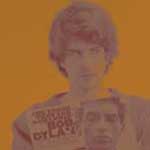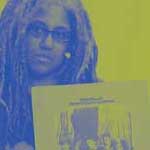 |  |
 |  |
With his career on a meteoric rise, Dylan returned to Toronto the following November, just weeks after releasing the single Like A Rolling Stone, which marked his first foray into using an amplified backing band. It was a tectonic shift for the acoustic folk singer and for his diehard fans.
“I was conflicted and a bit pissed off that Dylan was changing,” recalls Dr. Wainwright, now Dr. J.A. (Andy) Wainwright, professor of English at Dalhousie. “So I decided I wouldn’t go to the concert.”
Nevertheless, he and his girlfriend drove downtown to check out the scene around Massey Hall.
Dylan was the hottest new artist of the day, and had enlisted a local Toronto back-up band called Levon and The Hawks, who would later become The Band.
After the show, Wainwright parked discreetly across from the hall, and waited for the post-concert drama. “Sure enough, when he came out it was like Beatlemania. A couple hundred kids were all over his car, screaming.”
So when Dylan’s car pulled away, Wainwright slipped in behind and tailed him, right to the swanky Inn on the Park hotel.
“I hopped out of the car, and said something inane, like ‘I really like your music and would like to talk to you about it.’ Dylan looked at me, and looked at my girlfriend and said ‘Well, order some tea and come on up.’ ”
It was a different era, before burly security guards locked down a star’s perimeter. So the young Wainwright and his friend brought the tea to the room for a private audience with Bob Dylan.
“I sat with him for an hour and a half, one on one. We talked about literature and music,” recalls Dr. Wainwright. “He was tremendously kind, and genuinely interested in what I had to say.”
More than 40 years later, Dr. Wainwright teaches the popular course, English 2250: Bob Dylan and the Literature of the ’60s. Since beginning his career at Dalhousie in the early 1980s, he has frequently explored the cultural impact of Dylan’s work. It should be no surprise that Dylan’s work still generates interest from university students.
“Dylan is the single most important individual in western popular cultural expression in the last half of the 20th century,” says Dr. Wainwright, who has written extensively on Dylan. “He is a cultural presence, not just a personal presence the way so many popular celebrities are — there is a depth to his musical origins and creativity.”
The latest chapter in the unfolding Dylan saga is the recent release of the bold art film I’m Not There, putting Dylan’s strange storybook life back on the pages of mainstream media.
The film is a dense thinly-veiled biopic, with six actors portraying different characters who represent various aspects of the artist’s life — the young hobo kid riding the blinds, the early protest singer, the star burdened with drug and marital issues. Todd Haynes’ film has been garnering plenty of interest, largely for the bold move of casting Oscar-winning Cate Blanchett to portray the artist during the tumultuous ’65 –’66 years. (Blanchett won a Golden Globe award in mid-January for her role.)
Bob is no doubt smiling at the irony of the title. He is there, sort of a hovering presence, and has been since he first played at Gerde’s Folk City club in Greenwich Village in 1961, a raggedy folksinger carrying the troubadour torch of his hero Woody Guthrie.
The conceit of Haynes’ film, deconstructing the complexity of the various elements of the musician’s character by using entirely different actors (sometimes of different race and gender), is entirely appropriate, says Dr. Wainwright.
“The public figure of Dylan demands to be looked at from different perspectives. There never has been just one Bob Dylan, not even just one ’60s Dylan. There were a number of Dylans in that really essential period in which he created himself.
“In the ’70s, there was the Dylan who came back and toured with The Band, and the Dylan who did the magnificent Blood on the Tracks album, and then later the Dylan who becomes Christian.”
Dylan calls himself a “musical expeditionary” in Martin Scorsese’s illuminating 2005 documentary No Direction Home. He grew up in the conservative Minnesota iron range, where most young men laboured in surrounding mines. Dylan’s father, Abe Zimmerman, ran the local electrical store in Hibbing and had plans for young Bobby in the business.
Bob had other plans.
Dylan conjured the scruffy traveling minstrel persona, patterned on his hero Woody Guthrie. He often hood-winked interviewers with tales of growing up in New Mexico singing cowboy songs, or learning to sing blues in Chicago or black spirituals in the deep south.
“I felt I had no past,” says Dylan in No Direction Home. “I couldn’t relate to what I was doing at that time. It didn’t matter to me what I said at the time — it still doesn’t.”
However, what his canon of songs said have mattered a great deal. Dylan’s early songs helped bring awareness to the civil rights struggle in the U.S., to the unchecked nuclear buildup in the late stages of the Cold War and helped turn the popular tide against the U.S. war in South East Asia.
From his earliest days as a solo folk singer, Dylan was able to distill the social upheaval of the early ’60s into his lyrics. He was profoundly shaped by the cultural, social and political nature of the times. His lyrics played out like lush poetry, tantalizing and inviting interpretations.
Those lyrics still have resonance for yet another generation of Dylan fans, says Dr. Wainwright. His students come to class with differing understandings of Dylan and his cultural importance, but all are very aware of his presence — from his timeless early albums to recent Grammy-winning albums to his cheeky TV ads shilling ipods, Victoria’s Secret lingerie and Cadillac SUVs.
Dylan was early to grasp the potential of the new music as a vehicle for expressing his ideas. He began swapping the folk standards in his repertoire with his own topical songs, when few singers in the circuit were actually writing and performing original material.
Five years after leaving Hibbing, Dylan was at the top of the game, darling of the acoustic folk scene; influential protest singer, the voice for social change. Then Bob pulled the rug out from under the folkies at the 1965 Newport Folk Festival, fronting an electrified band to jolt his music into the future.
The conservative folkie audience was horrified at the apparent betrayal at Maggie’s Farm, watching the torchbearer of Woody’s Okie folkie music snub tradition, plug in his Stratocaster and fire up a rhythm section to supercharge his music.
“I can’t imagine he didn’t anticipate the reaction,” says Jacqueline Warwick, a musicologist and assistant professor of music at Dalhousie. She teaches a course in the history of rock ‘n’ roll, and Dylan’s work is pivotal.
“Dylan played (the Newport incident) just right to his own advantage. I don’t know if Pete Seeger ever got over it, but it earned Dylan a new fanbase and he did it at the right stage of his career. If he had waited another 10 years before going into rock, people would have asked ‘who’s this sad old man trying to get into the new music?’” says Dr. Warwick.
Like Miles Davis and Paul Simon, Dylan has continually explored different settings for his music, without appearing to be following the money. Through the tidal shifts of popular music trends — acoustic folk to rock, New Wave and disco, grunge and electronica — Dylan has maintained a presence in the popular culture.
“I think Dylan has established himself as the eminence grise of the whole genre,” says Dr. Warwick. “Anything new he releases, people will go ahead and buy. That works to his advantage — people listen to what he does because of what he’s done.”
Last year, Dylan marked 45 years as a recording artist by releasing the critically-acclaimed Modern Times CD, and won yet another Grammy for best contemporary folk/American album.
“Dylan has always kept people off balance, and has refused to be ‘essentialized’,” says Dr. Wainwright. “He takes those great songs and refuses to do them the same way — he doesn’t give people what they want.
“The words don’t change, and the quality of those words will last. But the rhythms and tone and inflection of the voice changes, and that reshapes the words and how they’re presented.”
His creative influence can’t reasonably be enumerated. Millions of young people picked up acoustic guitars, mastered the essential three chords and a turn-around and began scratching out heart-worn lyrics, inspired by Dylan’s wordplay. He’s even been nominated twice for a Nobel Prize in Literature.
“There is a kind of paradox about Dylan,” offers Dr. Wainwright. “His greatest artistry in terms of depth and consistency is in the ’60s — quantitatively as well as qualitatively. But I think Dylan has grown and changed and matured in profound and admirable ways since
that time.
“That’s part of watching him that’s been rewarding over the years.”
